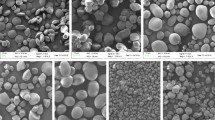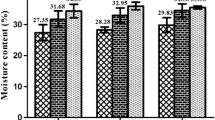Abstract
Resistant starch (RS) content was determined in the conventionally boiled (H1) and pressure-cooked (H2) cereals, legumes and tubers using enzymatic method. Both H1 and H2 legumes contained higher amount of RS as compared to cereals and tubers. H1 and H2 lentils showed highest RS content of 5.0 and 4.9% (dwb), respectively. Higher RS content in legumes can be attributed to the presence of intact tissue/cell structures enclosing starch granules and high level of amylose (26–33%) and high content of viscous soluble dietary fiber components. The decrease in RS content of H2 foods in comparison to H1 counterparts (maximum decrease of 15% in pea) might have occurred due to changes in cell wall integrity of H2 foods and this could result in increased accessibility of starch to amylolytic enzymes.
Similar content being viewed by others
References
AOAC (1984) Official methods of analysis. 14th edn, Association of Official Analytical Chemists, Arlington, VA
AOAC (1995) Total dietary fibers in foods — enzymatic-gravimetric method (985.29). Official methods of analysis. 16th edn, Association of Official Analytical Chemists, Arlington, VA
Berry CS (1986) Resistant starch: Formation and measurement of starch that survives exhaustive digestion with amylolytic enzymes during determination of dietary fibre. J Cereal Sci 4:301–314
Bird AR, Brown IL, Topping DL (2000) Starches, resistant starches the gut microflora and human health. Curr Issues Intestinal Microbiol 1(1):25–37
Bishnoi S, Khetarpaul N (1993) Effect of domestic processing and cooking methods on in vitro starch digestibility of different pea cultivars (Pisum sativum). Food Chem 47:177–182
Bravo L, Sidduraju P, Saura-Calixto F (1999) Effect of various processing methods on the in vitro starch digestibility and resistant starch content of Indian pulses. J Agric Food Chem 46: 4667–4674
Cairns P, Bogracheva TY, Ring SG, Hedley CL, Morris V J (1997) Determination of the polymorphic composition of smooth pea starch. Carbohy Polym 32:275–282
Deshpande SS, Cheryan M (1984) Effects of phytic acid, divalent cations and their interactions on α-amylase activity. J Food Sci 49:516–519
Englyst HN, Kingman SM, Cummings JH (1992) Classification and measurement of nutritionally important starch fractions. Eur J Clin Nutr 46(2):33–50
Gernat C, Radosta S, Damaschun G, Schierbaum F (1990) Supramolecular structure of legume starches revealed by X-ray scattering. Starch 42:175–178
Goni I, Garia-Alonso A, Saura-Calixto F (1997) A starch hydrolysis procedure to estimate glycemic index. Nutr Res 17:427–437
Goni L, Garcia-Dia Manas E, Saura-Calixto F (1996) Analysis of resistant starch: A method for foods and food products. Food Chem 56:455–459
Haralampu SG (1998) Physiological effects of resistant starch. In: The future of food: http//www.opta-food.com/access/starch.html (Accessed on 20 September 2002)
Haralampu SG (2000) Resistant starch—a review of the physical properties and biological impact of RS3. Carbohy Polym 41: 285–292
Hoover R, Sosulski FW (1985) Studies on the functional characteristics and digestibility of starches from Phaseolus vulgaris biotypes. Starch 37:397–403
Katyal D, Ghugre PS, Udipi SA (2005) Resistant starch in selected raw and processed legumes. J Food Sci Technol 42:506–510
Kavita V, Verghese S, Chitra GR, Prakash J (1998) Effects of processing time, storage temperature on the resistant starch of foods. J Food Sci Technol 35:299–304
Mahadevamma S, Tharanthan RN (2004) Processing of legumes: Resistant starch and dietary fiber contents. J Food Qual 27: 289–303
Mahmood I, Ghugre PS, Udipi SA (2006) Resistant starch in raw and processed roots and tubers. J Food Sci Technol 43: 282–285
Muir IG, O’Dea K (1992) Measurement of resistant starch: Factors affecting the amount of starch escaping the digestion in vitro. Am J Clin Nutr 56:123–127
Premavalli KS, Roopa S, Bawa AS (2006) Resistant starch — A functional dietary fibre. Indian Food Ind 25:40–45
Rosin PM, Lajolo FM, Menezes EW (2002) Measurement and characterization of dietary starches. J Food Comp Anal 15:367–377
Sharma A, Yadav BS, Ritika BY (2008) Resistant starch: Physiological roles and food applications. Food Rev Int 24:193–234
Siddhuraju P, Becker K (2001) Effect of various domestic processing methods on antinutrients and in vitro protein and starch digestibility of two Indigenous varieties of Indian tribal pulse Mucana pruriens Var. utilis. J Agric Food Chem 49: 3058–3067
Tharanathan M, Tharanathan RN (2001) Resistant starch in wheat-based products: isolation and characterization. J Cereal Sci 34: 73–84
Williams PC, Kuzina FD, Hlynka I (1970) A rapid colorimetric procedure for estimating the amylose content of starches and flours. Cereal Chem 47:411–420
Wursch P, Dal Vedovo S, Koellreuter B (1986) Cell structure and starch nature as key determinants of the digestion rate of starch in legume. Am J Clin Nutr 43:25–29
Author information
Authors and Affiliations
Corresponding author
Rights and permissions
About this article
Cite this article
Yadav, B.S., Sharma, A. & Yadav, R.B. Resistant starch content of conventionally boiled and pressure-cooked cereals, legumes and tubers. J Food Sci Technol 47, 84–88 (2010). https://doi.org/10.1007/s13197-010-0020-6
Received:
Accepted:
Published:
Issue Date:
DOI: https://doi.org/10.1007/s13197-010-0020-6




